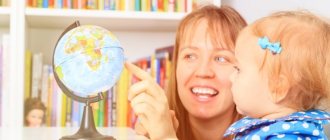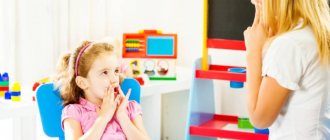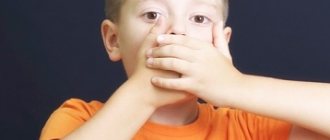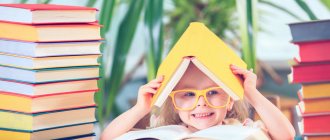Alalia is a defect in which a person cannot speak, but perceives speech well. Patients cannot speak because they are unable to form a normal sentence or because they have a limited vocabulary.
In severe cases, speech is completely absent and the help of a professional speech therapist is required. A specialist at the speech center in Moscow will make a differential diagnosis of congenital speech underdevelopment and prescribe effective treatment.
It is most difficult to cure alalia in an advanced stage - the sooner you contact a specialist, the more favorable the prognosis. If your child has problems with conversational learning, it is best to consult a speech therapist immediately.
Parents should be alert to the following symptoms:
- the child cannot formulate a sentence, remains silent for a long time and constructs phrases;
- at the same time, the baby hears everything, understands and reacts to comments;
- The child lags behind his peers in development and has difficulty learning to speak.
Motor alalia
Motor alalia is characterized by the presence of a lesion in the brain. With this form of the disease, there are problems with speech, but intelligence is preserved. The part of the cerebral cortex that is responsible for speech production is affected. This form of pathology usually develops before the age of 3 years; as the child grows older, he begins to have complexes about his condition and uses facial expressions and gestures in conversation.
The main difference between motor alalia is that the child has difficulty speaking without visual perception. If he does not see a specific image, he cannot name it. Only during perception are neural connections formed between the centers of the cerebral cortex. Simple phrasal sentences remain in a rudimentary state, for example:
- "I'm here";
- "Come here";
- “Let me play”;
- “Let's go home”, etc.
Parents are not always able to detect motor alalia in the early stages, which is why they do not immediately turn to specialists. For full treatment, constant monitoring by a neurologist is required. The speech therapist selects a program depending on the specific clinical situation. The mild form is easier to correct; if you contact specialists in a timely manner, the prognosis is favorable.
Construction of lessons
With sensory alalia, speech therapy is aimed at training a number of reactions. It is necessary to train not only phonetic hearing itself, but also motor skills, memory, and attention. The training system should be built comprehensively.
Another point is environmental control. Any sound source has an impact on the patient, so it is important to arrange quiet modes. It is also better to reduce the number of sound stimuli for the patient so that he can better learn to isolate the necessary sounds. Reducing sound stimuli is also used during classes. The main task of speech therapy work for sensory alalia is to teach the patient to understand speech in various situations and to form competent speech independently.
Exercises can be done in the format of various games. Children love games and this will help them remember the lesson better.
Sensory alalia
Sensory alalia is characterized by a disorder of speech perception through the sensory organs. It is often confused with deafness because the symptoms and behaviors appear similar to hearing loss. In fact, the child does not differentiate and does not understand sounds; for him, any speech sounds like a set of incomprehensible foreign words. With this pathology, speech is heard monotonous and it is not clear where one word ends and another begins.
Typical symptoms of sensory alalia:
- speech is present, saturated with a large number of incomprehensible monotonous words;
- the child repeats for a long time the same words that he hears from adults;
- there are rough alterations of words, in which syllables and prefixes are swapped;
- The vocabulary is small, consisting of simple words or short phrases.
Children with sensory alalia experience many difficulties in life, it is difficult for them to communicate with peers and study, they are behind in development. To solve this problem, you need to start working with a specialist as early as possible and select a corrective program. The patient is observed by several doctors, each prescribing therapy according to his own profile. Only with joint and coordinated treatment can an optimal result be obtained.
Symptoms
In general, the child can speak. Communicates actively, sometimes too emotionally. However, sensory alalia affects the child’s critical assessment of his speech. Because of this, he may not even understand what he is talking about. Symptoms include:
- Although hearing is preserved, attention is unstable. There is an increase in sensitivity to a number of sounds - hyperacusis.
- A violation of phonemic speech perception also manifests itself - the brain does not process the signals entering it. Because of this, the child does not understand what he heard.
- It is very difficult to remember sounds.
- Signs of logorrhea, a tendency to create words and phrases that do not exist, may appear. It is also possible to mix syllables, words, phrases.
- An obsessive desire to repeat words and phrases heard, for example, from cartoons or advertising. The difficulty in detecting a symptom is that what the child says may seem like something meaningful. However, if the phrase changes, he will no longer be able to understand it.
Sensorimotor alalia
There is also a combined type of the disease – sensorimotor alalia. With this form, signs of both pathologies are noted:
- damage to the speech motor analyzer of the cerebral cortex is observed;
- sensory disorders are noted, the child does not understand and does not differentiate speech;
- over time, fatigue, lethargy and apathy appear, the child cannot maintain attention for a long time;
- Usually, with sensorimotor alalia, there is a developmental delay; consultation with a psychiatrist is required.
The most common causes of sensorimotor alalia are complicated pregnancy or childbirth, which causes brain injuries. In severe cases, other organic lesions of the central nervous system are also recorded. An accurate diagnosis is made only after an instrumental examination of the patient by specialized specialists.
Classes with a speech therapist for sensorimotor alalia are a mandatory part of the rehabilitation program. The speech center conducts individual trainings and classes in groups; a corrective program is selected for each individual. Complex treatment is necessary to eliminate organic pathology and restore the physiology of speech.
www.Logopedy.ru
Author : Tropko Evgeniya Sergeevna, teacher-speech therapist, MBDOU kindergarten No. 3 “Zvezdochka” of combined type, city. Noginsk, Moscow region
Original:
The essence of speech therapy work is not to teach alalik the rules of grammar, writing, reading, but to instead of the disturbed channels of speech activity, include those that have been preserved, make them work harder, perform double or even triple the workload. Such a complex task requires frequent use of various pre-language skills. These are gestures, rhythmic movements, drawing, imitation of non-speech sounds, for example, the howling of the wind, the voices of animals. As these skills are mastered, the child is introduced to speech-like sounds and words that gradually become more complex in meaning. Techniques for such work are available only to highly qualified specialists, and parents can only help speech therapists here, but not replace them. Speech therapy work for alalia should begin early, as soon as a child’s lag in speech development is noticed, since speech is not formed independently and without the help of a speech therapist. In any case, the absence of speech by the age of 2 is already an alarming signal.
In case of sensory alalia, speech therapy is aimed at nurturing a conscious analysis of the composition of speech, the development of phonemic perception, and understanding of speech structures.
When teaching children with sensory alalia, special methods are used aimed at developing activity, forming sound and morphological analysis and the semantic side of speech. This takes into account the level of underdevelopment of understanding, one’s own speech, cognitive activity, and general characteristics of the child’s personality.
The main principle of the work is a consistent and systematic impact on all aspects of the child’s speech activity in their interrelation. The work is effective only when the doctor carries out specific treatment that normalizes the activity of the central nervous system and stimulates the maturation of cells in the cerebral cortex.
Stage 1.
The work begins not with perception, but with the development of attention. The child is taught non-verbal facial tasks: Seguin board, tracing, coloring, mosaic, drawing, shading, making pictures from cubes, stringing beads. At the same time, we are working on developing efficiency and observation skills. At this stage, the child’s activity should be non-speech.
Stage 2.
They learn to distinguish and differentiate sounds that are similar in sound, a sound noise series of more distant sounds to closer sounds of a non-speech nature (bell, drum, rattles, tambourine, hitting a glass with a spoon, hitting a table). Gradually the sound and noise range increases and becomes more complex. For example, distinguishing the noise of compressed paper and polyethylene film.
Stage 3.
Inclusion of a strong, monotonous speech sound in the sound-noise series: r-r-r-r. As soon as the child begins to isolate a speech sound from the noise range, this sound materializes through one of the toys (dog, vacuum cleaner, airplane, etc.). Moreover, it materializes only through one specific toy. Then the following sound is taken: a-a-a, it is also determined and materialized through a specific picture. All sounds are repeated, speech sounds are especially emphasized, and at the same time we enter a letter. As a result, the child must, through a specific picture, show the letter “R” with the sound “P” (airplane). For the sound “A”, show the doll and the letter “A”. At this stage, we constantly establish a connection between the sound image and the letter.
Stage 4.
We include syllables in the work. Children learn syllables that can be used to designate objects: ball - pa-pa-pa, cow - mu-mu-mu, dog - aw - aw - aw. Images of objects must be specific and colorful, in appropriate colors. Learning at this stage is global and holistic. We move from syllables to words. MAC, JUICE, - pictures - letters. The child learns to distinguish words that are distant in meaning (transport-poppy). In parallel with this work, a list of standard instructions for everyday use is being compiled. “Get a handkerchief. “Wipe your nose” - pronounced with the same intonation, repeatedly against the background of a series of sound and noise. We definitely help the child with a gesture - “open the door”, highlight it with intonation, and show the sign. Training is carried out using a conditioned reflex method, through reinforcement of sounds and actions, through demonstration of instructions and display of instructions on tablets. A set of physical exercises is taught with speech accompaniment “arms up, arms to the sides.....”.
Stage 5.
Work is carried out along logical, thematic chains. All exercises are performed in microdoses. In milder cases, work is being done to develop phonemic hearing. Isolating a specific sound from a number of sounds: a- y- O- t-p. , syllable emphasis: SA-RA-SHA-da. Next, we select a word from a series of words: garden-house-COM-cancer. We arrange pictures with a given sound at the beginning of the word, in the middle, at the end. We select pictures from the dictionary for a specific sound. Game “Chain of words” MA——lina
——rina
--tire.
Determine the linear sequence of sounds.
It is easier to identify and distinguish sounds in someone else's speech than in your own. Sounds should be pronounced at intervals. Then the child must name the whole word: R_U_CH_K_A. The child must learn to merge sounds into words and retain sounds in memory.
Individual plan for corrective development of a child
for the 2021 – 2021 academic year Last name, first name of the child _______________________________________________
Year of birth ______________________ Year of study ________________
Conclusion of the PMPC _________________________________________________
Tasks:
1. Development of speech understanding 2. Development of active imitative speech activity 3. Development of general speech skills 4. Development of phonemic hearing
Development of speech understanding
Teach your child:
1. Find objects and toys at the request of the teacher.
2. According to the speech therapist’s instructions, recognize and correctly show objects and toys.
3. Show body parts as requested by an adult.
4. Understand general categories:
· work is carried out primarily on specific material (and not pictures) in a life situation; · it is necessary to achieve true understanding, and not rote memorization: the concept of “transport” is formed not only from a picture book or from cards, but also on the street, at the station, etc., the concept of “vegetables” is reinforced at the market, in the grocery store, etc.
5. 5. Show and perform actions related to the outside world, familiar everyday or play situations:
· actions according to verbal instructions: “Show me where auntie is? Here she is! Show me where your aunt's eyes are? Here they are! Show me where your aunt's hands are? “Here they are”; · tasks based on speech instructions, including 1-2-3 actions (Take the doll. Take the doll and give it to Masha. Take the doll, put it at the table, feed it); · tasks based on speech instructions, including spatial relationships between objects: on, under, in, behind (example: “Put the car on the table. Place the matryoshka doll under the chair. Find the doll, it’s in the closet. Bring the car, it’s under the table, etc.) .
6. Strengthen the skill of conducting a one-way dialogue (the speech therapist asks a question about the content of the plot picture, and the child answers it with a gesture).
7. Perceive the questions in a differentiated manner: who?, where?, where from?, with whom?.
8. Understand the categories of singular and plural nouns and verbs.
9. Distinguish by ear appeals to one or more persons.
10. Understand the categories of gender of singular past tense verbs: Valya was reading a book.
11. Guess objects, toys, animals, birds based on their verbal description (big, brown, club-footed, lives in a den, sucks a paw).
12. Understand the functional meaning of objects. At the request of an adult, select objects to perform the named actions (cutting - knife, sewing - needle, pouring soup - ladle).
13. Determine cause-and-effect relationships (snow - sleds, skates, snow woman).
Lexical topics: “Toys”, “Clothing”, “Furniture”, “Dishes”, “Food”, “Transport”.
Development of active imitative speech activity
Teach your child:
1. Name parents, relatives (mom, dad, grandma).
2. Name the names of friends and dolls.
3. Cause speech imitation on vowel sounds and their combinations (Katya sings: a-a-a; The train is humming: o-o-o; Parsley is surprised: o-o-o; The mouse squeaks: i-i-i; In the forest shout: au; Baby cries: wa; Donkey screams: ya.)
4. Reinforce the pronunciation of the same syllables: Yes, yes, yes! Ba-ba-ba-ba! Mom mom! Pa-pa-pa-pa!;
5. Create onomatopoeia with the voices of animals and sounds of the surrounding world
· based on open syllables: cow - mu; mouse - pi; finger - bo-bo; car - beep; gus - ha-ha-ha; chicken - ko-ko-ko; · based on closed syllables: ball - bang; dog - aw-aw; gnome - yum-yum; kettle - puff-puff; · based on the material of syllables with a consonant cluster: frog - kva - kva - kva; duck - quack, quack, quack; piglet - oink, oink-oink, etc.).
Successful sound complexes are repeated in a playful manner several times (up to 5-10 repetitions).
6. Clear expression of your desires:
· “Yes”, “No”. · “I want”, “I don’t want.” · “I will”, “I won’t.”
7. Point to certain objects: here, this, here.
8. Give orders: here, go, give
9. Make up first sentences, for example: Here is the ball. This is Danya.
10. Express your needs with a simple phrase (2-3 words) in a specific situation: “Auntie, give me!”, “Kolya, go to the ball,” “Mom for a walk,” “Let’s go to bed.”
11. Make sentences according to the model: address + imperative verb: Mom, sleep.
12. Convert imperative verbs into verbs of the present tense singular number of the 3rd person (sleep - sleeps, go - goes).
13. Reflect in speech in a form accessible to the child the results of observations in nature and in everyday life (“Where was Daniel? Walking. What did he see there? Snow. Who did he walk with? Nanny. What is the nanny’s name? Aunt Galya. Who did he see? Lena.)
14. When reciting nursery rhymes, poems, rhymes to adults, perform certain actions, learn finger games with speech accompaniment: for example, rhymes: “We shared an orange, there were many of us, but he was one. This slice is for the hedgehog, this slice is for the siskin, and this one is for Masha”; “The mice came out one day to see what time it was. One, two, three, four, the mice pulled the weights, suddenly there was a terrible ringing, the mice ran away,” and others.
A game. “ For pancakes ”: (the child’s name is called) began to gather guests. - Claps your hands, then the right, then the left hand on top. - And Ivan come, And Stepan come, And Andrey come, And Matvey come. – The tip of the half-bent index finger of the right hand hooks in turn the tips of the half-bent fingers of the left hand, starting with the thumb, and gently shakes them. - And Mitroshechka: Well, please! — the index finger of the right hand persistently shakes the little finger of the left hand four times. Anya began to treat the guests: Damn it to Ivan, Damn it to Stepan, Damn it to Andrey, Damn it to Matvey, and Mint gingerbread for Mitroshechka!” - Claps your hands, then the right, then the left hand on top. The left hand is turned palm up, the thumb of the right hand presses on the pads of each finger of the left, starting with the thumb, as if placing a pancake. Anya began to see off the guests: “Goodbye, Ivan!” - Goodbye, Stepan. - Goodbye, Andrey! - Goodbye, Matvey! The fingers of the right hand bend the fingers of the left towards the palm, starting with the thumb. - And you, Miroshechka, my little one, stay with me a little longer! The first three fingers of the right hand gently stroke the little finger of the left from top to bottom.
Gradually, the child should begin to try to independently name the corresponding word. It is important to encourage any, even the most distorted, reproduction of it. At the same time, the speech therapist correctly and clearly repeats this word after the child.
In this case, special techniques are used to help actualize speech:
· the appearance and sudden disappearance of an object that was first named, and then the question is asked - What is it? Who is this? Who was hiding?; joint pronunciation of the word; · reflected speaking; · finishing a word in a situation that suggests the right word.
Development of general speech skills
Formation of the optimal type of physiological diaphragmatic breathing for speech.
1. Form speech breathing (calm short inhalation and smooth long exhalation):
· Without speech accompaniment (for example, “Let’s smell the flower”, “Ships”, etc.) · With speech accompaniment (based on vowel sounds and their combinations, isolated voiceless fricative consonants /F/, /X/, syllables with these consonants, words , later - gradually spreading phrases, the pronunciation of which requires a continuous, long exhalation (3-4 words).
2. Develop voice strength (quiet - loud) and voice modulation (high - low).
3. Develop the correct moderate tempo of speech (speech with movement, singing with movement).
4. Form primary ideas about the intonation expressiveness of speech through emotional reading to the child of nursery rhymes, poems, and fairy tales.
5. Develop the ability to convey accents by hitting a tambourine, clapping your hands and maintaining pauses.
6. Teach intonation imitation of the voices of animals and birds.
7. Teach to reproduce the intonation-rhythmic pattern of a word while simultaneously tapping the syllables with hand movements.
8. Teach expressive storytelling of nursery rhymes, short poems, and fairy tales.
9. Activate the movements of the articulatory apparatus and facial muscles in the process of performing articulatory imitation exercises in a playful manner:
· “Smile” - Keeping your lips in a smile. The teeth are not visible. · “Tube” - Stretching the lips forward in a long tube. · “Smile-pipe.” Pull your lips forward with a tube, then stretch your lips into a smile. · "Dissatisfied horse." The flow of exhaled air is easily and actively sent to the lips until they begin to vibrate. The result is a sound similar to the snorting of a horse. · “Fat men.” Inflate both cheeks, then inflate the cheeks alternately. · “Skinny girls.” Pull in your cheeks. · "Ball". Mouth closed. Hitting the puffed-out cheeks with your fist, causing the air to come out with force and noise. · "Spatula". The mouth is open, a wide, relaxed tongue rests on the lower lip. · "Cup". The mouth is wide open. The anterior and lateral edges of the wide tongue are raised, but do not touch the teeth. · "Needle". The mouth is open. The narrow, tense tongue is pushed forward. · "Fungus". The mouth is open. Suck your tongue to the roof of your mouth. · "Watch". The mouth is slightly open. The lips are stretched into a smile. With the tip of the narrow tongue, alternately reach at the teacher’s count to the corners of the mouth. · "Swing". The mouth is open. With a tense tongue, reach for the nose and chin, or the upper and lower incisors. · "Football". Mouth closed. With a tense tongue, rest on one or the other cheek. · "Brush your teeth". Mouth closed. Move your tongue in a circular motion between your lips and teeth. · "Horse". Suck your tongue to the roof of your mouth and click your tongue. Click slowly and firmly, pulling the hyoid ligament. · “Delicious jam.” The mouth is open. Using a wide tongue, lick your upper lip and move your tongue into the back of your mouth.
Development of phonemic hearing
1. Teach the child to distinguish non-speech sounds and their direction:
· tapping; · patting; · rustling of paper; · door creaking; · tambourine sounds; sounds of a metallophone; sounds of maracas · sounds of the toy (squeaking).
2. Teach differentiation by ear:
· nouns whose names differ in one sound. The child shows the pictures named by the speech therapist: mouse - bowl; roof - rat; daughter - dot; · nouns that differ in several sounds and are similar in sound-syllable structure: donkey - goat; donkey - goat; lawn - carriage; snake - earth; cart - nose; · verbs that sound similar (the speech therapist asks questions about the “story” pictures): who rides - who bathes; who bathes - who buys; who they graze - who they carry; who carries - who carries.
3. Teach the child to identify by ear the sound complexes “Mocking a doll (a-a-a-a)”, “Sore ear (o-o-o-o)”, “Echo” (lost in the forest - ouch), “Tearful” baby" (wa-wa) among other sound combinations.
Social commentary Cackle
Expressive alalia
Expressive alalia is a language disorder in which speech acquisition is impaired during learning. Simply put, the child does not understand what is being said to him and, as a result, cannot learn to speak correctly. There is a disconnection in the construction of words with grammatical, lexical and phonemic errors. The exact causes are not fully understood; there is a relationship between speech disorder and organic brain damage.
Risk factors for the development of expressive alalia:
- burdened heredity;
- difficult pregnancy;
- complicated childbirth;
- traumatic brain injuries in children at an early age.
With the expressive form of pathology, it is difficult for children to adapt because they do not understand spoken language well. Symptoms of the disease are similar to sensory alalia, but in the expressive form there are individual disturbances in word search, agrammatism, difficulties with the choice of phonemes and their construction, and disturbances in the syllabic structure of words.
For any form of alalia, you need to consult a specialist in a timely manner - only a professional can accurately diagnose and establish the cause of the disorder. A competent examination gives half the success in treatment.
The speech therapist will talk with the patient and determine the cause of the defect - sometimes children develop a little slower than their peers. In any case, it is better not to delay a visit to a specialist; this will help to identify the disease in a timely manner and eliminate the cause before the development of a persistent pathological condition.
Correction and treatment of children with alalia in Khabarovsk
If a child is diagnosed with alalia, treatment should be comprehensive. That is, to include methods of psychological, medical and pedagogical orientation. The following methods of therapy are used:
- Treatment using drugs that stimulate the development of brain structures.
- Speech therapy exercises and massage aimed at developing speech and normalizing the tone of the muscles involved in sound pronunciation. Exercises should be carried out in courses, systematically.
- Microcurrent reflexology – to activate the speech areas of the cerebral cortex.
- Physical therapy, physiotherapy methods (laser and magnetic therapy, electrophoresis, water treatment).
- Stimulation of improved coordination and development of fine motor skills.
- Early teaching of children's literacy and writing.
The Neocortex center uses the most effective advanced techniques for correcting alalia in children. We have modern equipment, leading psychologists, teachers, doctors, and rehabilitation specialists cooperate with us. Carefully developed treatment programs are used.
Prognosis and prevention
The prognosis depends on the age at which sensorimotor alalia is diagnosed in children and the timing of initiation of therapy. If the diagnosis is made in preschool age, the child receives adequate treatment, regularly works with a speech therapist and psychologist, then it is possible to stop the progression of the disease and teach the patient communication skills. Articulation is normalized. Subsequently, he is socialized and can study in a regular school.
The participation of parents in the correction of sensorimotor alalia and their understanding of the complexity of the situation is very important. Unfortunately, such violations do not go away on their own. A good result requires patience, desire and effort on the part of both parents and baby. Try to motivate the baby, encourage, praise for success. Follow your speech therapist's recommendations.
If you trigger sensorimotor alalia, then stuttering, mental retardation, and nervous tics may occur. This will worsen the already difficult prognosis and negatively affect the future life of the child.
Prevention consists of clear pregnancy planning. The expectant mother should eat a balanced diet, get enough rest, and see a doctor regularly. During childbirth and the first years of the baby’s life, you should carefully monitor its development, prevent injuries and promptly treat infectious and other diseases.
If you find symptoms of sensorimotor alalia, contact a specialist so that they can examine you and identify the cause of this condition.
Causes of the disease
Sensorimotor alalia develops due to damage to areas of the brain that are responsible for understanding and reproducing speech.
A damaging factor can affect different periods of a child’s development:
- In the prenatal period, infectious diseases in a woman, the threat of miscarriage, polyhydramnios or oligohydramnios, premature rupture of water, entanglement in the umbilical cord, bad habits, taking medications, concomitant diseases, vitamin deficiencies have a negative impact;
- During childbirth, there is an increased risk of birth injuries and hypoxia, in which the brain experiences oxygen deficiency or is damaged. The use of forceps and rapid labor are dangerous;
- After childbirth and the first years of the baby’s life, brain damage can occur as a result of injuries, encephalitis and meningitis, and severe concomitant diseases.
Relationships with parents play an important role in the development of sensorimotor alalia. It has been proven that children whose parents are distant towards their baby ignore his needs for love, communication, care, and lag behind their peers in development. This also applies to speech development.
Therapy
Each child with sensorimotor alalia needs an individual approach and the development of a special correction plan. It is almost impossible to provide optimal conditions in a regular kindergarten or primary school for an alalik child. The treatment of sensorimotor alalia itself should be complex and consist of many factors. The therapy itself is based on several types of treatment, one of which is speech therapy classes.
They can be either group or individual. It is important to know that classes should be carried out systematically. Speech pathologists and speech therapists help to correctly place phonemes and sounds, and develop the ability to understand the speech of others. For exercises, pictures and toys are used, as well as activities aimed at fine motor skills. All skills must be consolidated. To do this, all exercises are repeated with parents under their supervision.
Speech therapy massage is used. It is aimed at strengthening and developing the muscles of the mouth, ensuring normal articulation. One of the components of the correction of sensorimotor alalia is physiotherapy - medicinal baths, magnetic therapy and others. Medicines are also used - stimulants of brain cell regeneration, nootropics, vitamins.
In the first stages of work, a speech pathologist and speech pathologist teaches the child to perceive sounds and reproduce them. At the second stage, words or short phrases are constructed and vocabulary is enriched. The third stage is the last, where speech flow is formed, grammatical rules are taught, and previously acquired skills are consolidated. Specialists of various profiles work with the child - speech therapists, defectologists, psychiatrists, neurologists, psychologists.
Main reasons
The main causes of sensorimotor alalia:
- intrauterine infections (rubella, herpes, toxoplasmosis and others);
- hypoxia, toxicosis;
- birth injuries;
- hydrocephalus (atrophy of parts of the child’s brain);
- complications after meningitis;
- chronic diseases in the mother;
- traumatic brain injuries in early childhood.
All cases of sensorimotor alalia are accompanied by mental retardation. It is impossible to give a positive, guaranteed prognosis for complete rehabilitation of the disease - much depends on the time of treatment. If correctional work is started late, it is extremely difficult to avoid intellectual underdevelopment. In this case, training in a specialized (correctional) school will be required.
Prognosis for recovery
If you do not receive proper rehabilitation, there may be risks of dysarthria, stuttering, neuroses, tics and other problems. Often children with the sensorimotor type of alalia experience difficulties with socialization and communication with people around them. Complete relief from sensorimotor alalia is possible only with the correct selection of treatment methods and compliance with all doctors’ requirements. After correction, mental development gradually normalizes. There is the possibility of compensation up to the development level of peers.






